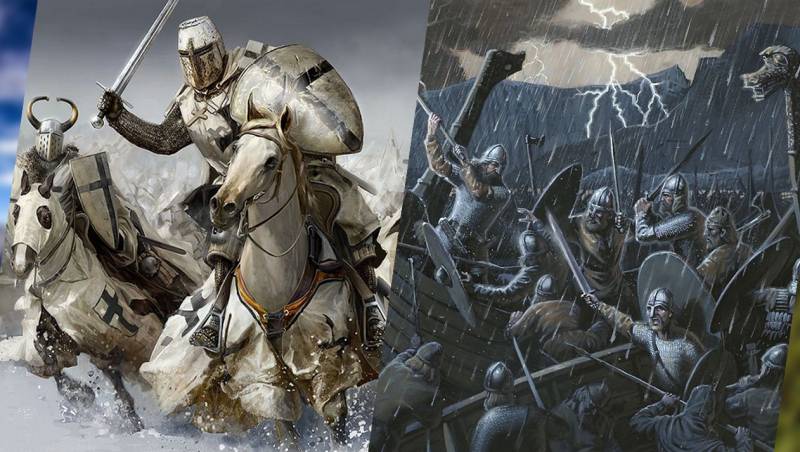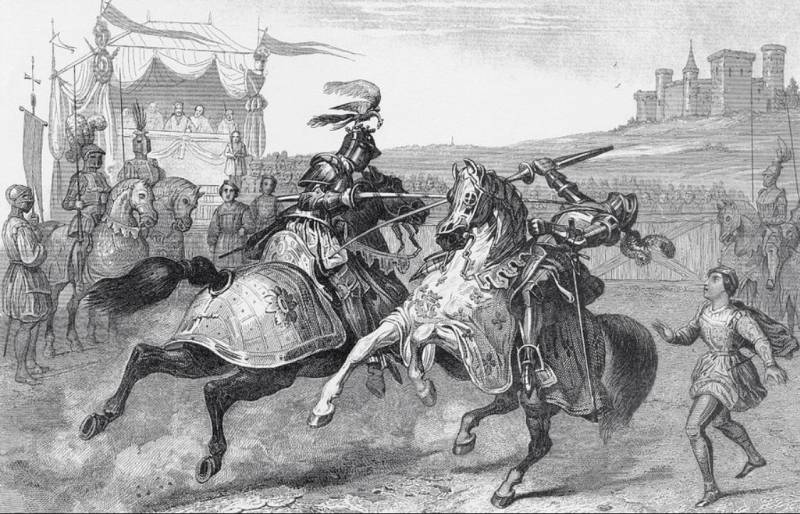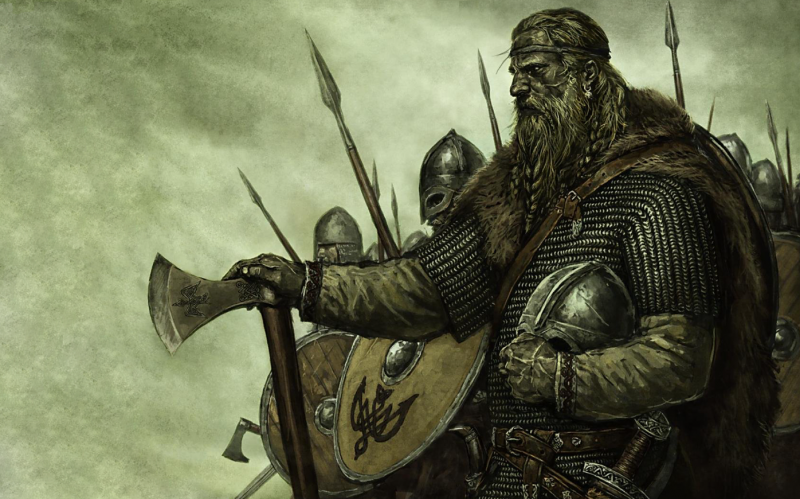Ancient German military ethics as the source of the code of honor of knights of the Middle Ages

Chivalry is inextricably linked both with the world of wars and mounted warriors, and with the concept of “aristocracy,” for knights were usually people of noble birth. British historian Maurice Keane notes that chivalry can be defined as a certain ethos in which military, aristocratic and religious components are fused together [1]. Chivalry denoted the code and culture of the military class, which regarded war as its hereditary profession.
One of the features of Western European chivalry is that military craft became the subject of intense ideological exaltation - there was simply no “way to the top” for knights who knew no other career than the military. For this reason, the elements of war brought professional warriors not only inevitable suffering and hardship, but also significant opportunities for advancement up the social ladder. War turned for them into the main or even the only means of self-realization from childhood until the end of their lives [2].
In science, there is an opinion that the main sources of the political and legal culture of the Middle Ages were, firstly, Roman law, which retained its enormous authority, and, secondly, canon law, based on Christian dogma. However, we should not forget about the most important source - the ancient Germanic military traditions with their emphasis on personal freedom and the dignity of the armed man (“the law of the sword” and custom, as opposed to the “written law”). The culture of chivalry as the socially dominant class of the Middle Ages was based precisely on the law of custom [3].
Some researchers rightly note that the most important for knightly ideology were the pagan traditions of the ancient Germans. After all, the idea of chivalry originates from the traditions of German tribal formations of the era of military democracy.
In this material we will consider issues related to the origin of knightly ideology, knightly virtues and their connection with ancient German military ethics.
About the knight's code of honor

Chivalry is essentially a secular, war-oriented upper-class code of honor. He owed his Christian motives to the fact that these social groups operated within the emerging Christian society, where the Christian cult was the basis of social and religious life. Chivalry flourished from the mid-1th to the mid-XNUMXth centuries as the ethos of the dominant secular class of Christian Europe, and its characteristic external forms corresponded to the social, political and cultural conditions of those times [XNUMX].
Chivalry - as described in medieval treatises - is a specific way of life in which we can distinguish three main aspects: military, aristocratic and religious. The aristocratic aspect of chivalry is not just about birth; it is associated with the most important function of chivalry and that scale of values, according to which nobility primarily depends on the self-worth of a person, and not just on his birth [1].
The “Knight’s Code of Honor” is a special phenomenon in European culture that arose in the XNUMXth century. Truly knightly virtues, in Old French called “largesse” (conventionally “breadth of soul”) and “courtoisie” (“courtiness”), were considered military valor, a sense of honor, loyalty, moderation and generosity. The code of knightly honor also assumed loyalty to one's word as an immutable rule of conduct. Knightly communities, grouped into orders and brotherhoods, conceptualized their group interests through the prism of the duty of fidelity to their word.
Military valor in the medieval sense was considered as
The priority of “military valor” over other virtues in the “knight’s code of honor” was caused by the special relevance of military actions - the main sphere of manifestation of this quality at that time [5].
If a knight suddenly behaved unworthily, forgetting the chosen prototype and violating the code of honor, then he did not always get away with it. A special ritual of “demoting a knight” was practiced. French historian Michel Pastoureau writes about this, in particular. The one who had stained himself was elevated to the scaffold, placed astride a log, his head was doused with hot water to “wash away” the previous dedication, and weapon and the shield was broken and trampled underfoot. In this form, the ritual took shape by the beginning of the 6th century [XNUMX].
Maurice Kean notes that chivalry arose and was nurtured in France, but it found its final form in the pan-European context. It became widespread as a kind of unified ethos of the military class, identified, on the one hand, by the skill of mounted warriors, and on the other, by a combination of an extremely proud attitude towards one’s ancestors with the tradition of faithful service to one’s lord [1].
In French medieval literature of epic content, such knightly virtues as valor, loyalty, magnanimity and generosity were perceived as stereotypes of noble (knightly) behavior. However, these secular qualities already constitute the main features of the hero of more ancient German literature, the roots of which go back to the pre-Christian past. For example, these are the main virtues in the warrior society depicted in the Anglo-Saxon epic Beowulf.
The ethics of chivalry largely originated from the ancient German military ethics. It was precisely because of the ancient and deep-rooted military dream of glory and recognition that no sermons or religious teachings could bring down the military fervor characteristic of the ideal knight, for, as Tacitus said when he wrote about the ancient Germans and their thirst for battle, “renown is easiest won among perils” (“glory is easiest to achieve in times of danger”) [Tacitus, Germania].
German military traditions as the source of chivalry

Not only XNUMXth-century books on the Middle Ages and chivalry, but even major recent studies, such as the works of Franco Cardini and Jean Flory, begin with or do not ignore ancient Germany. This is not surprising, since it was German society that foreshadowed medieval chivalry.
Russian historian, specialist in the field of Scandinavian studies Alexander Khlevov notes that numerous facts suggest that the Germanic tribes, going through a stage of development characteristic of all early societies, colored it with their own flavor: a pronounced idealization of war and exaggerated attention to it. The given vector will later be reflected in the phenomenon of medieval European chivalry [4].
Early Germanic society was characterized by a strict ethical code that valued trust, loyalty, and courage above all else. Fame in ancient Germanic society was an absolute value, and life without honor for the ancient Germans was simply unthinkable.
- Tacitus wrote about the customs of the ancient Germans. It was in this that German society differed from the Roman Empire and anticipated medieval chivalry. The incentive for everyone was honor.
The main source of honor and glory for the ancient Germans was war. In German customs, as Franco Cardini notes, it is sacred. The god of war Wotan (Odin) exists surrounded by a squad (Gefolg-schaft) - a retinue of valiant men. Like him, the German leader, who has earned his authority through valor, strives to imitate the divine example in everything and is looking for worthy comrades for his retinue [8].
Terms such as “valor” (virtus) or even “audacity”, “fearlessness” (audacia) - a word, we note, is much stronger - are not sufficient to convey the spirit with which the Celt and German fought in antiquity or the early Middle Ages [ 8].
In the imagination of the German warrior, who acquires strength and aggressiveness thanks to initiation, connected through it by indissoluble bonds with warriors and illustrious leaders like himself, joining a military family based on valor and a common destiny, brotherhood and identity with formerly strangers blood, coexists with natural ties of clan [8].
Among the Germans, thanks to joining a fighting squad, an almost consanguineous relationship was established between its leader and ordinary members. The warriors who were part of such a detachment had every right to maintain order in the possessions of their commander, as if they belonged to his family; in the same way, he had the right to restore order and dispose of the households of those whom he armed and took into maintenance, and from their killers he demanded payment of a blood debt, wergeld, according to the rate that corresponded to his own status, and not the killed warriors from his squads - everything is again as if the members of the squad were his relatives. We find similar views in chivalry [1].
Scandinavians went on Viking campaigns to gain fame, to remain in the memory of their descendants, and also to increase their social status. The Saga of Harald Graypelt, for example, says:
As for chivalry, the necessary attributes of an ideal knight were also a thirst for exploits, conquests, victories, a desire for glory and daring, bordering on recklessness. The war for chivalry also had a religious connotation, with the only difference being that the ancient pagan religion was replaced by Christianity.
For the ancient Germans, youth was a time of trials, searches and attempts by a young warrior to prove what he was capable of. This is reflected, for example, in Beowulf, as well as in Germanic epic poems of the 1th-XNUMXth centuries written in Latin, for example, in Ruodlieb and Waltharius. Subsequently, this theme is found in later works - chivalric romances - where young knights leave their home (or the court of King Arthur) in order to prove their knightly worth during unprecedented adventures [XNUMX].
Many knightly traditions - such as, for example, the consecration of swords - also have ancient roots associated with the distant pre-Christian past and the traditions of the ancient Germans. Thus, the sword of Roland Durendal has its counterpart in the German-Scandinavian “Walder” (X-XI centuries) in the form of the Mimming sword, forged by the great blacksmith of the German-Scandinavian pantheon Wieland. And the relics enclosed in the hilt of Durendal (the tooth of St. Peter, the hair of St. Dionysius, a piece of clothing of the Virgin Mary) have their analogue in the Scandinavian magical “stones of life” embedded in the hilts of pagan swords [1].
Thus, the emergence of the knightly mentality is in one way or another connected with the ancient German military tradition, the German code of heroic values.
Conclusions
So, knightly culture has its roots, on the one hand, in the depths of self-awareness of the ancient Germanic peoples with their cult of the leader, personal loyalty and military valor, and on the other hand, in the concept of service developed by Christianity.
The ideal of devotion to a lord in war undoubtedly came from the German squads, but veneration of a superior and ardent devotion became the norm of all social life, a norm that was sanctified by Christian morality. All this limited, first of all, the unbridled “knightly” free will [10]. The rider was required not so much to distinguish himself in war, but to serve, which was unusual for the freedom-loving Germans.
German comitat - squads bound to the leader by an oath of allegiance - which one could join thanks to the glory gained in battle by one's ancestors and which were brotherhoods in arms, were the living soul of the knightly Middle Ages. Shall we take the epic example of Roland-Olivier or historical evidence from the times of the Crusades, the complementarity of brothers in arms is so important that it can be argued: the specific embodiment of the ideal of a perfect knight was most often found not in one individual hero, but in a pair of them, where they are united by weapons [8].
Based on the foregoing, we can conclude that the idea of chivalry originates primarily from the ancient German and Celtic principles of military democracy, built on the principles of a free armed man, as the social basis of society.
In conclusion, it should also be noted that the special attitude of the ancient Germans to weapons was also subsequently reflected in chivalry. In particular, historian A. Khlevov notes the following:
Использованная литература:
[1]. Maurice Keene. Chivalry. – M.: Scientific world, 2000.
[2]. Orlova E.I. “Education by service” in the knightly culture of the European Middle Ages. // News of the Volgograd Pedagogical University. Series “Socio-economic sciences and art”. 2009. No. 8(42). P.8-12.
[3]. Karpovsky A. S. Subculture of chivalry in the context of the political and legal culture of Medieval Europe: dis. Ph.D. cultural studies, Moscow. state University of Culture and Arts. – M., 2003.
[4]. Quote from: Khlevov A.A. A brief history of the Middle Ages: Epoch, states, battles, people - St. Petersburg: Amphora, 2008
[5]. Manukhina A.O. “Reflection of the “knight’s code of honor” in the medieval discourse of the Crusades. [Electronic resource] URL: https://cyberleninka.ru/article/n/otrazhenie-kodeksa-chesti-rytsarya-v-srednevekovom-diskurse-epohi-krestovyh-pohodov-na-materiale-starofrantsuzskih-dokumentalnyh
[6]. Pastoureau M.P. Everyday life in France and England during the time of the Knights of the Round Table / trans. from fr. M. O. Gonchar; scientific ed., comment. and after. T. D. Sergeeva; preface A. P. Levandovsky. – M.: Young Guard, 2009.
[7]. Cornelius Tacitus. Works in two volumes. Volume I. “Annals. Small works." Scientific-ed. Center "Ladomir", M., 1993.
[8]. Cardini F. Origins of medieval chivalry. – M, Progress, 1987.
[9]. The Saga of Harald Gray Skin // Sturluson S. Circle of the Earth - M.: Nauka, 1980.
[10]. Barthelemy D. Chivalry from ancient Germany to France of the 2012th century. St. Petersburg: Eurasia, XNUMX.
[eleven]. Khlevov A. A. Harbingers of the Vikings. Northern Europe in the 11st–2019th centuries. – St. Petersburg: Eurasia, XNUMX.
Information